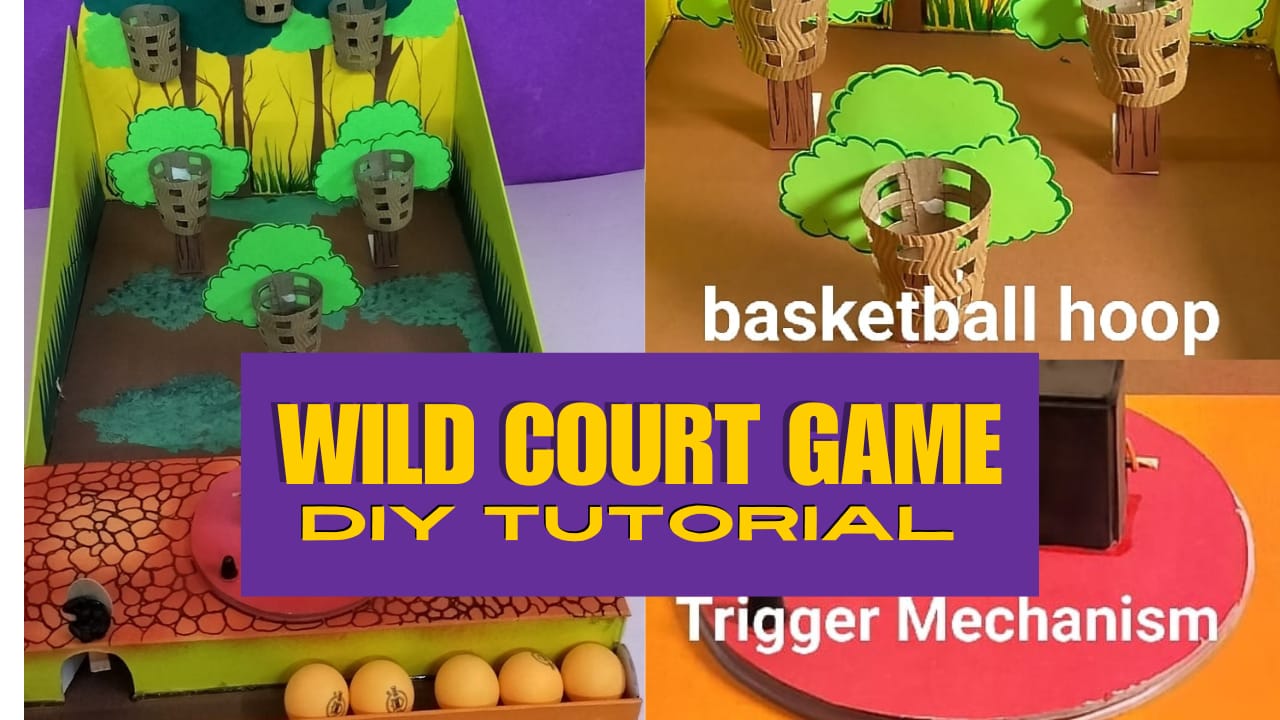Are you looking for an engaging and fun project for your next school exhibition? A Wild Court Game Model could be just what you need! This interactive and creative project will grab attention and provide a playful way to teach others about sports, strategy, or teamwork. Let’s dive into how you can create your own Wild Court Game Model step by step.
What Is a Wild Court Game Model?
A Wild Court Game Model is a miniature representation of a sports court or game arena with a unique, creative twist. Unlike traditional models, the “wild” element introduces unconventional rules, designs, or themes that make it stand out. It’s a fusion of sports and imagination, perfect for demonstrating creativity and problem-solving skills.
Materials You Will Need
- Cardboard
- Pastel sheets
- Super glue
- (FEVIBOND)
- Hot glue gun
- Chop sticks
- Old pen rifle
- Old pen cap
- Wooden spoon
- Table tennis balls
- Paper Cup
- Pen and markers
Steps for Making the Wild Court Game Model
Step 1: Decide on the Game Theme
The first step is to determine the theme of your Wild Court Game. Will it be based on basketball, soccer, or tennis? Or will it feature a completely new sport with its own set of rules? Here are some ideas:
- Fantasy Basketball Court: Add obstacles like magical portals or hoops at different heights.
- Jungle Soccer Field: Include elements like rivers, bridges, and jungle animals as barriers.
- Space-Themed Tennis Court: Add craters and low-gravity zones to make it wild.
Your theme will guide the design and functionality of the court.
Step 2: Create the Base
- Choose the Size: Decide how big your model will be. A 24” x 18” base is a manageable size for most exhibitions.
- Cut the Base: Use cardboard, wood, or foam board and cut it to the desired dimensions.
- Mark Boundaries: Use a ruler and pencil to outline the court’s boundaries. Add zones or lines specific to your game, such as penalty areas, net placement, or scoring zones.
Step 3: Design the Court
- Paint or Color the Base: Use paint or colored markers to create the surface. You can mimic grass, hardwood, or any material that suits your theme.
- Add Details: Use craft paper or stickers to mark important areas like the centerline, goalposts, or sideline markings.
- Build Obstacles or Barriers: Add hills, tunnels, or walls using recycled materials to make the court unique and challenging.
Step 4: Add Game Components
Players or Tokens
- Use small figurines, LEGO pieces, or bottle caps to represent players. Decorate them with paint or markers to match the theme.
- Place the players strategically based on the game rules.
Goals and Nets
- Construct goalposts using straws or sticks.
- Use string or mesh to create a net for games like tennis or volleyball.
- Secure these components with glue or tape.
Scoring System
- Create a simple scoreboard using cardboard or paper.
- Add numbers or dials that can be adjusted manually to track points.
Step 5: Define the Rules
A Wild Court Game isn’t complete without its own set of unique rules. Write them clearly and display them alongside your model. For example:
- Players can only move diagonally or jump over obstacles.
- Bonus points are awarded for hitting specific targets on the court.
- Penalty zones require players to skip their next turn.
These rules will make your model more interactive and fun.
Step 6: Add Final Touches
- Label Key Areas: Use small flags or markers to label zones, such as “Goal Area” or “Bonus Zone.”
- Test the Game: Play a few rounds with friends or family to ensure the game works and is enjoyable.
Related –School project front page border design for project | PDF DOWNLOAD
How to Present Your Model
When presenting your Wild Court Game Model at the school exhibition, follow these tips:
- Demonstrate Gameplay: Invite visitors to try the game and explain the rules clearly.
- Highlight Creativity: Point out the innovative elements, like obstacles or scoring mechanics.
- Answer Questions: Be ready to explain how you built the model and what you learned during the process.
Benefits of Making a Wild Court Game Model
Creating a Wild Court Game Model has several educational and personal benefits:
- Develops Creativity: Designing unique themes and obstacles encourages out-of-the-box thinking.
- Enhances Problem-Solving Skills: Figuring out how to build functional components is a hands-on learning experience.
- Promotes Teamwork: Working with friends or classmates fosters collaboration.
- Engages Others: Interactive models make science and sports more fun for everyone.
Conclusion
Building a Wild Court Game Model for a school exhibition is a fantastic way to showcase your creativity and engineering skills. From choosing a unique theme to constructing obstacles and setting rules, every step is an opportunity to learn and have fun. Follow the guide above, and you’ll have an impressive project that’s sure to wow your teachers and classmates. Good luck, and enjoy building your Wild Court Game Model!
Wild Court Game Model for School Exhibition Project
A Wild Court Game Model could be just what you need! This interactive and creative project will grab attention and provide a playful way to teach others about sports, strategy, or teamwork. Let’s dive into how you can create your own Wild Court Game Model step by step.

I and also my friends happened to be examining the best suggestions on your site and so suddenly developed a horrible suspicion I never thanked the web site owner for those secrets. Most of the women became consequently warmed to see all of them and now have honestly been taking advantage of them. Appreciation for genuinely really considerate and for obtaining this sort of very good ideas most people are really wanting to discover. Our own sincere regret for not expressing appreciation to sooner.